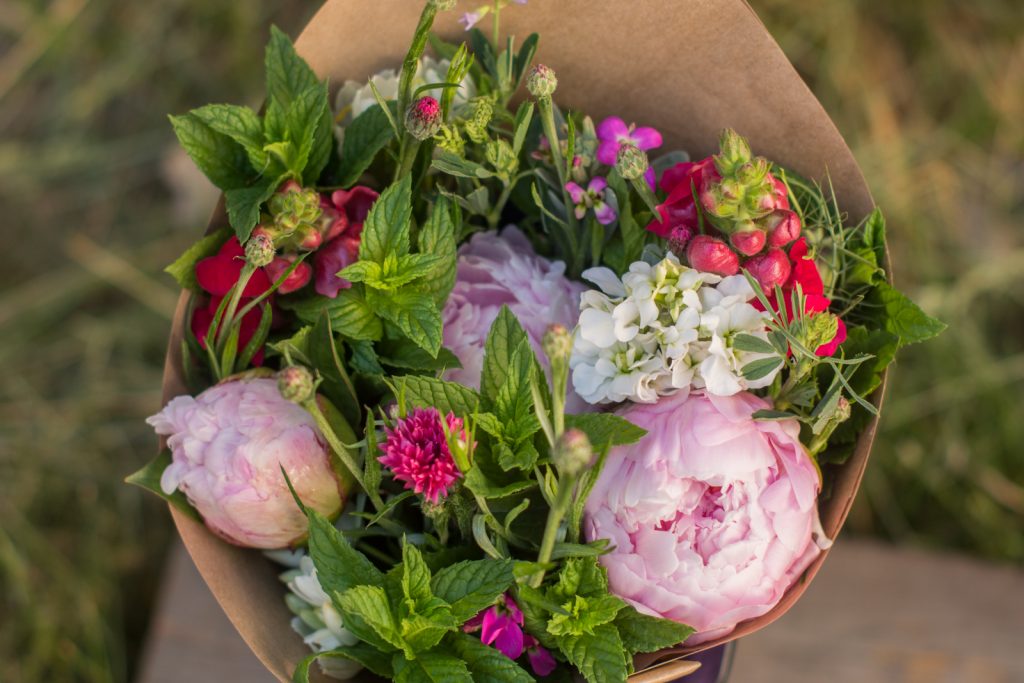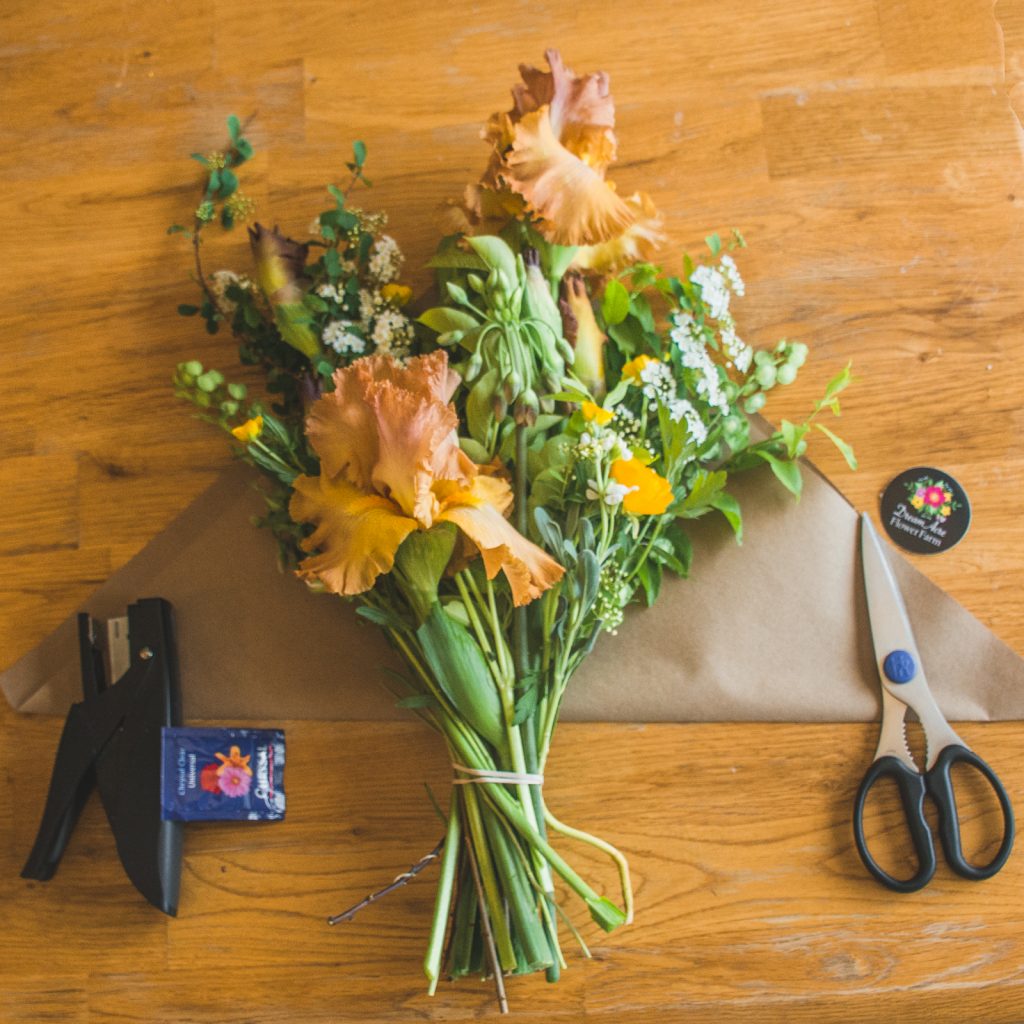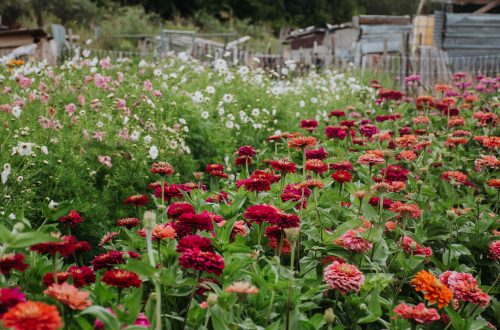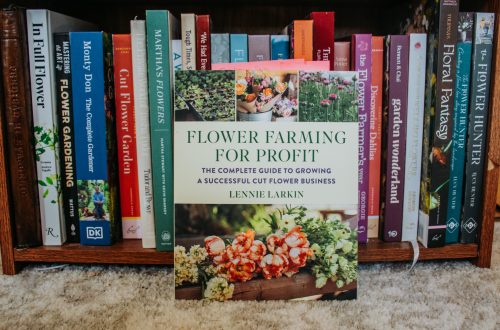
In milder parts of the world like the UK, the month of June is one of the most abundant when it comes to what’s flowering and what you can harvest in a cut flower garden or farm. In Utah, however, June is a notoriously tricky time for flower farmers and home gardeners alike, simply because you’re past the spring blooming bulbs like tulips, but your summer flowers just aren’t there yet.
While there are obviously additional flowers than these that can bloom in June, I’m restricting my list exclusively to flowers that are good for cutting. I’ll start with the focal flowers that I count on to make bouquets, and then I’ll add a few supporting flowers and fillers/foliage to the list so you get a good idea of your options if you’re trying to start a cut flower farm in Utah.
For some background, we’re located in a high altitude town in Central Utah. Although we’re technically a Zone 6a, our growing season is actually extremely short when compared to most of Utah, especially along the Wasatch Front and then down in Southern Utah. For the past couple years, we’ve had frosts in mid-June and our season usually ends in late September. If you live in one of those areas in Utah with a significantly longer season (such as Salt Lake or St. George), your blooms are typically about 2-4 weeks ahead of ours.
Note: There are affiliate links below to products and books mentioned.

June Focal Flowers
As flower farmers, we always have to have many, many backups in case certain crops fail in order to guarantee that we’ll still have flowers to fulfill our CSA bouquet subscriptions. In the list below, all the flowers are dependent on weather. If the spring goes by in a flash and the heat waves come early, the ranunculus crop goes dormant. If it’s a cooler, more mild spring, then the Asiatic lilies probably won’t start blooming until July. Therefore, because you can’t control the weather, we plant some of everything so that we (hopefully) won’t have any period within the month without focal flowers.
Ranunculus
While ranunculus is notoriously tricky to grow (and really grows best in Utah when overwintered in a high tunnel), it’s a high value crop that can go for up to 8 weeks in mid to late spring, which can be especially valuable in years when your tulip crop fails or blooms super early. Ideally, you’ll presprout ranunculus and plant it in a high tunnel in November, which means you can expect blooms the following April or so until the heat starts to pick up sometime in June. You can also plant it out in March with minimal to no protection, but your stems will likely be significantly shorter and the bloom time only 3-4 weeks or so.
Irises
I’ll admit I’m not a huge fan of bearded irises as a gardener, but I quite like them as cut flowers in an arrangement simply because they’re so dramatic, plus they bloom at a time when few other things are available. In my experience, the Dutch irises tend to bloom first (ours did in May), and the bearded irises show up after, starting in late May and going into early June. The latest to bloom are the Siberian iris, which showed up around mid-June for us.
Poppies
Poppies don’t make great cut flowers just because they’re generally so short-lived in a vase, but there are exceptions. Icelandic poppies have a decent vase life if you can get them to grow for you, and Oriental poppies can last 5-6 days in a vase if you make sure to cut them right at cracking stage and sear the ends in boiling water or with an open flame immediately upon cutting (also note that they do shed pollen like mad near the end). Poppy pods, on the other hand, make a great statement in arrangements.
Peonies
Like tulips, peonies come in early, mid- and late-season varieties depending on the cultivar. Around here, the earliest varieties tend to start coming on in late May and the latest varieties can go almost all the way until the end of June. The hardest part about peonies is that you often have to wait a few years upon planting them bare root to get any kind of usable blooms off of them, but once they’re established and happy, they will produce masses of blooms for decades.
Roses
Roses are generally a pretty reliable June bloomer, especially if the bush is established. While roses will never win a vase life contest, most people are generally smitten enough with garden roses that you can still get away with using them as a focal flower, even if they do only last a handful of days in your bouquet.
Sunflowers
You’ll notice that pretty much everything up to this point (with the exception of some poppies and the ranunculus) are plants that are perennial. Therefore, if you want to consistently have blooms available in June, you pretty much need to plan on establishing several perennials. However, if you’re just starting out and don’t have established perennials yet (or weren’t able to plant bulbs back in the fall), you can get an early crop of sunflowers by starting them indoors in early April and planting them out 2-3 weeks later, which is about a month before our last frost date. They definitely won’t be as tall and perfect as sunflowers planted under hotter conditions, but sunflowers SAVE ME every single June from about the third week on.
Asiatic Lilies
In years when the spring tends to be a flash in the pan and the heat comes on quick, I’ll usually have the first of my perennialized Asiatic lilies blooming by the very end of June. Those will continue on through July, with the Oriental lilies taking over around August or so.

June Supporting Flowers
While many of June’s focal flowers rely on perennials and bulbs, there are actually quite a lot of supporting flowers you can start in the same growing season, or that you can start the previous summer and overwinter. For how to do this, you simply MUST read the book Cool Flowers by Lisa Mason Ziegler. I think it’s a must-own book (since I’m constantly referring to it), but it clearly and thoroughly explains everything you need to know about the group of plants known as hardy annuals, which will absolutely save you come June since they’re basically the only thing blooming that early next to bulbs and perennials.
Alliums
Alliums are an extremely diverse group of hundreds of different kinds of bulbs that all tend to bloom in late spring or early summer. While I love the gigantic globe alliums that look like fireworks in my garden, I prefer the daintier varieties for cutting like azureum, drumstick, and the cultivars that look more like tiny sprays of flowers rather than spheres.
Star of Bethlehem
I was told this wouldn’t overwinter successfully in my zone, but I tried some anyway, and much to my delight — they did! I tried the classy, goes-with-everything white Arabicum, and I’m crossing my fingers that they’ll keep coming back year after year.
Bachelor’s Buttons
I can direct sow this out in the very beginning of March and reliably have blooms by mid-June. While bachelor’s buttons can be tricky to use as cut flowers just because of the growth habit of the plant, I’ve found that if you can pinch the central stem when it’s just 4-5″ high down to the lowest set of true leaves that it will then produce long, very usable and easy to harvest stems. You can still use it if you don’t pinch, but rather than having several long, single blooms to harvest, you’ll just be cutting a small bush basically. I love the pops of color that bachelor’s buttons bring to both the landscape and to bouquets.
Snapdragons
If you either overwinter your snapdragon plants or start them very early (like February) inside and then transplant them out by mid-April, you’ll generally always have blooms by mid to late June. Snapdragons are probably my favorite cut flower ever, just because they never seem to fail me, and I love their vast diversity of colors and bloom shapes.
Bells of Ireland
These can be tricky to 1) germinate and 2) get to a long enough stem length, but if you pop them in the freezer for a week or so before direct sowing them in early March, you’ll usually solve both problems. The lime green bells bring a freshness to whatever they’re paired with, and since many people have never seen them, they provide a great talking point as well.
Nigella (Love in a Mist)
Once you have nigella, you’ll likely always have it just because it’s such a prolific self-seeder, but I personally love that about it. (Free flowers!) The best and most usable nigella will come from seedlings that sprout up around September and that overwinter for you, which is what happened for us this year. By June, we had masses of the gorgeous, tall blue and white flowers that I cut on endlessly for weeks.
Stock
Stock is a tricky crop to grow in Utah just because of our volatile springs, but I’ve had the most success with growing the Iron variety (which tends to tolerate heat better), and planting successions of it every two weeks starting in late January and going into late April. My first successions I plant out in our high tunnel, and everything from mid-April on goes out into our raised beds under shade cloth.
Larkspur
For some reason, larkspur is super tricky for me to get to germinate (even when I freeze the seeds), but when I have been able to get some to germinate — and especially to overwinter — I absolutely love using it in arrangements. I find that it’s a more usable spike than delphiniums and foxgloves (which also bloom in June), and I also love that it’s more of a cut and come again kind of flower.
Daisies
Almost everyone loves a cheerful daisy, and they are just about the easiest perennial ever to grow. Also, bonus — they have an insanely good vase life.
Bellflowers
Bellflowers are a biennial, which means you need to sow them the summer before you want them to bloom. But I think they’re absolutely worth the extra bit of trouble! If you cut them just as the first couple of bells are opening, the vase life is often over a week, and I love the bubbly texture they bring to an arrangement.
Saponaria
This is a new filler flower to me this year, and I have absolutely loved it! I direct sowed a bunch in March and April, and I had quite a few of the long, dainty, bouncing flowers ready for me by June. This has a look very similar to Covent Garden annual baby’s breath, but for me, it’s far easier to grow and get a decent stem length on.

June Foliage/Fillers
Spirea
Spirea is one of the most valuable shrubs we have on our property because in the spring, its frothy white flowers spill romantically out of every wrapped bouquet I put it in, and then later on, its pretty foliage acts as a nice greenery in the late summer.
Cress
Cress is super quick from seed to harvest — about 60 days is all. If you sometimes struggle with getting your cress to bloom and produce seed pods on long enough stems, try overwintering it (as we do) — your stems will be much more usable. I loved the pennycress I tried last year so much that this year I’m trying two more varieties: a dragon cress from Floret, and Persian Cress from Johnny’s Seeds.
Mint
Mint might be a bully for the home gardener, but WOW, do I love it as a flower farmer for that exact reason! Nothing fills up a bed so fast, and it is one of my absolute favorite fillers and foliages to use in my bouquets for as long as I have it. In fact, I loved my mint patch so much (and was cutting off it so regularly) that I’m now trying to establish two NEW large mint patches.
Raspberry foliage
While our raspberry foliage isn’t the most ideal because it does have thorns, I still welcome using it every June just because it’s so reliable and it provides a great base for any arrangement or bouquet. If you are planning to use raspberry bushes for cut flower bouquets, please do yourself a favor and make sure you plant a thornless variety!
Feverfew
Near the end of June, one of my absolute favorite fillers of all time — feverfew — takes the spotlight. Just a couple stems of feverfew completely fill out almost any arrangement, and the dainty, daisy-like sprays of flowers are so cheerful and loved by everyone. It does have an herbal fragrance that takes some getting used to, but it is SO worth growing, and growing a lot of.
Alfalfa
Finally, I have to include alfalfa on my list, even though I’ve never planted any. Often, despite my best planning and intentions, I still have to go foraging a bit in June to have enough filler and greenery to work with, and alfalfa is almost always what comes to the rescue. It lasts a surprisingly long time in the vase, and the purple flowers (which range from light tones to a super deep violet) are a nice bonus. Whenever I see a weedy patch of alfalfa start up somewhere in my yard, I always let it be in June in order to use it for greenery!
And there you have it! My favorite varieties of cutting material for June. Drop a comment below to add your own favorites to the list, and, as always, don’t hesitate to ask me any questions you might have!






